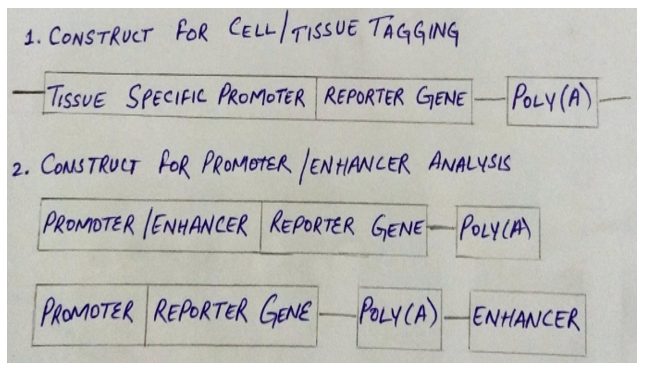This set of Marine Biotechnology Multiple Choice Questions & Answers (MCQs) focuses on “Fish Genetics and Biotechnology”.
1. Which is a promoter from zebrafish?
a) GAP43
b) Heat shock protein 70b
c) β-actin
d) β-tubulin
View Answer
Explanation: In transgenic technology promoters or enhancer elements are used to properly express the foreign genes in marine organisms. Heat shock protein (Hsp70b) is a promoter of fish origin, GAP43 is a promoter of rat origin.
2. Foreign genes are integrated in the genomes of transgenic marine organisms.
a) True
b) False
View Answer
Explanation: In transgenic marine organisms such as fish, crustaceans, microalgae, and macroalgae exogenous fragment of DNA is introduced and integrated in the genomes. Techniques such as microinjection and electroporation are used in transgenesis.
3. Which promoter of fish origin is a strong promoter of transgenes in most fish tissues?
a) α-tubulin
b) EF-1α
c) VTGC
d) β-actin
View Answer
Explanation: β-actin is a strong promoter derived from the common carp has been shown to drive strong expression of transgenes in various types of fish tissues. The same promoter from chicken and medaka fish is also used in the biomedical research.
4. Heat shock protein 70 is a __________________
a) non-inducible promoter
b) inducible promoter
c) reporter gene
d) elongation factor
View Answer
Explanation: Heat shock protein 70 (hsp70) is a tissue-specific inducible promoter that has been used to control the expression of transgenes in desired type of tissue under specific conditions in the research experiments.
5. Activation of hsp70 controlled transgenes can be achieved by ____________________
a) ionization, chemical treatment
b) milling, chemical treatment
c) heat shock, chemical treatment
d) heat shock, laser treatment
View Answer
Explanation: Heat shock protein 70 is an inducible and tissue-specific promoter used for controlling the expression of transgenes. The activation of transgenes is done using heat treatment and focusing sub lethal laser microbeam.
6. Gain-of function, reporter-function and loss-of-function are the types of ___________________
a) transgenes
b) electroporation methods
c) reporter genes
d) enhancer elements
View Answer
Explanation: Depending upon the type of gene transfer studies, the types of transgenes are grouped into the following: gain-of function, reporter-function and loss-of-function. There are phenotypic changes associated with each.
7. Identify the prototypes of transgene.

a) Genomic gene, cDNA
b) cDNA, mRNA
c) cDNA, tRNA
d) Genomic gene, tRNA
View Answer
Explanation: The gain-of-function transgene prototypes in the figure are genomic gene and complementary DNA (cDNA) in the given figure. Such transgenes are under the control of homologous or heterologous promoters.
8. Absence of signal peptide sequence in the transgene leads to secretion of gene products.
a) True
b) False
View Answer
Explanation: Presence of signal peptide sequence in the transgene leads to secretion of the gene products once they are synthesized. Such sequences can be identified and incorporated while designing the gene construct.
9. Luciferase and cameleon are examples of _____________________
a) transgenes
b) enhancers
c) exons
d) reporter gene
View Answer
Explanation: The reporter genes such as luciferase, green fluorescence proteins, cameleon, chloramphenicol acetyltransferase etc. are used to quantify the expression of transgenes and to identify the sequences of undefined promoters.
10. Which is a fluorescent calcium sensor?
a) Cameleon
b) Red fluorescent protein
c) Luciferase
d) Neomycin phosphotransferase
View Answer
Explanation: Cameleon is a fluorescent calcium sensor being used in transgenic zebrafish (Danio rerio) to monitor the neuronal activity. This reporter gene was also used for the detection of calcium transients in Caenorhabditis elegans.
11. Identify the prototypes of transgene.

a) Reporter function
b) Enhancer analysis
c) Loss-of-function
d) Gain-of function
View Answer
Explanation: The prototype of reporter function is given in the figure – transgene constructs for specific tissue targeting, and for promoter/ enhancer analysis. Various specific reporter genes and conventional reporter genes are used in biomedical research.
12. Aequorea victoria, the source of GFP is a ___________
a) mummichog
b) damselfish
c) jellyfish
d) avian
View Answer
Explanation: Aequorea victoria is a jellyfish which is the source of green fluorescent protein (GFP) used in transgenic technology, as a reporter gene. Many variants of GFP such as the yellow, and blue fluorescent proteins exist.
Sanfoundry Global Education & Learning Series – Marine Biotechnology.
To practice all areas of Marine Biotechnology, here is complete set of 1000+ Multiple Choice Questions and Answers.
If you find a mistake in question / option / answer, kindly take a screenshot and email to [email protected]
